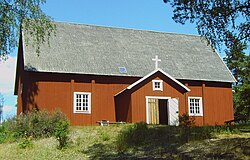
Back Loppi AVK Loppi (munisipyo) CEB Loppi German Loppi Esperanto Loppi Spanish Loppi vald Estonian Loppi Basque لپپی Persian Loppi Finnish Loppi French
Loppi | |
|---|---|
Municipality | |
| Lopen kunta Loppi kommun | |
 Saint Bridget Church (Santa Pirjo) | |
 Location of Loppi in Finland | |
| Coordinates: 60°43′N 024°26.5′E / 60.717°N 24.4417°E | |
| Country | |
| Region | Tavastia Proper |
| Sub-region | Riihimäki sub-region |
| Founded | 1632 |
| Seat | Loppi (kirkonkylä) |
| Government | |
| • Municipal manager | Mikko Salmela |
| Area (2018-01-01)[1] | |
| • Total | 655.97 km2 (253.27 sq mi) |
| • Land | 597.69 km2 (230.77 sq mi) |
| • Water | 58.36 km2 (22.53 sq mi) |
| • Rank | 140th largest in Finland |
| Population (2023-12-31)[2] | |
| • Total | 7,692 |
| • Rank | 122nd largest in Finland |
| • Density | 12.87/km2 (33.3/sq mi) |
| Population by native language | |
| • Finnish | 96.2% (official) |
| • Swedish | 0.5% |
| • Others | 3.4% |
| Population by age | |
| • 0 to 14 | 16% |
| • 15 to 64 | 58.1% |
| • 65 or older | 25.9% |
| Time zone | UTC+02:00 (EET) |
| • Summer (DST) | UTC+03:00 (EEST) |
| Website | www.loppi.fi |
Loppi (Finnish: [ˈlopːi]; Swedish: Loppi, also Loppis) is a municipality in Finland. It is located in the province of Southern Finland and is part of the Kanta-Häme region, located about 50 kilometers (about 30 miles) south of the city of Hämeenlinna. Loppi was founded in 1632. The municipality has a population of 7,692 (31 December 2023)[6] and covers an area of 655.97 square kilometres (253.27 sq mi) of which 58.36 km2 (22.53 sq mi) is water.[1] The population density is 12.87 inhabitants per square kilometre (33.3/sq mi). The municipality is unilingually Finnish.
Neighbour municipalities are Hyvinkää, Hämeenlinna, Janakkala, Karkkila, Riihimäki, Tammela and Vihti. The most significant main road connection to get from Loppi to Riihimäki is the national road 54, which runs between Tammela and Hollola, and which is connected to the Highway 3 (E12) between Helsinki and Tampere. Another significant road connection in the direction of Helsinki is the regional road 132 passing through the municipality of Nurmijärvi.
The subject of the municipal coat of arms, where the iron symbol has sunk into a wave-cut plate, refers to the lifting of limonite from the lake in the early period.[7][8]
According to local folklore, Kaakkomäki of Loppi was inhabited by a giant devil in ancient times. When Loppi's old church, Saint Bridget Church, was built in the 17th century, the devil tried to disrupt the construction and became enraged when the church bells rang. The devil tried to destroy the church bell tower and threw it with a large rock. However, the rock flew over the church to Tiirinkallio on the shore of Lake Loppijärvi, from where the rock was combed into the lake. The stone in the lake brought a disaster: cattle fell ill and animals died. So the villagers crammed the rock up the cliff and the luck of the cattle was restored.[9]
Loppi is especially known for its potato cultivation,[10] and the potato is classified as the municipality's title plant.[11] Potato porridge and lingonberry broth cooked from barley flour, as well as a sweetened potato casserole and meat sauce, were named the traditional food of the Loppi parish in the 1980s.[12]
- ^ a b "Area of Finnish Municipalities 1.1.2018" (PDF). National Land Survey of Finland. Retrieved 30 January 2018.
- ^ "Population growth biggest in nearly 70 years". Population structure. Statistics Finland. 2024-04-26. ISSN 1797-5395. Retrieved 2024-04-29.
- ^ "Population growth biggest in nearly 70 years". Population structure. Statistics Finland. 2024-04-26. ISSN 1797-5395. Retrieved 2024-04-29.
- ^ "Population according to age (1-year) and sex by area and the regional division of each statistical reference year, 2003–2020". StatFin. Statistics Finland. Retrieved 2 May 2021.
- ^ a b "Luettelo kuntien ja seurakuntien tuloveroprosenteista vuonna 2023". Tax Administration of Finland. 14 November 2022. Retrieved 7 May 2023.
- ^ "Population by municipality as of 31 December 2008". Population Information System (in Finnish and Swedish). Population Register Center of Finland. Archived from the original on 2010-12-02. Retrieved 2 May 2010.
- ^ Suomen kunnallisvaakunat (in Finnish). Suomen Kunnallisliitto. 1982. p. 146. ISBN 951-773-085-3.
- ^ "Sisäasiainministeriön vahvistamat kaupunkien, kauppaloiden ja kuntien vaakunat 1949-1995 I:10 Loppi" (in Finnish). National Archives of Finland. Retrieved March 2, 2021.
- ^ Loppilainen taru (in Finnish)
- ^ Loppi tunnetaan perunasta - tulevaisuudessa mahdollisesti myös harvinaisesta perhoslajista? (in Finnish)
- ^ Lopen nimikkolajit (in Finnish)
- ^ Jaakko Kolmonen: Kotomaamme ruoka-aitta: Suomen, Karjalan ja Petsamon pitäjäruoat, p. 69. Helsinki: Patakolmonen Ky, 1988. (in Finnish)
